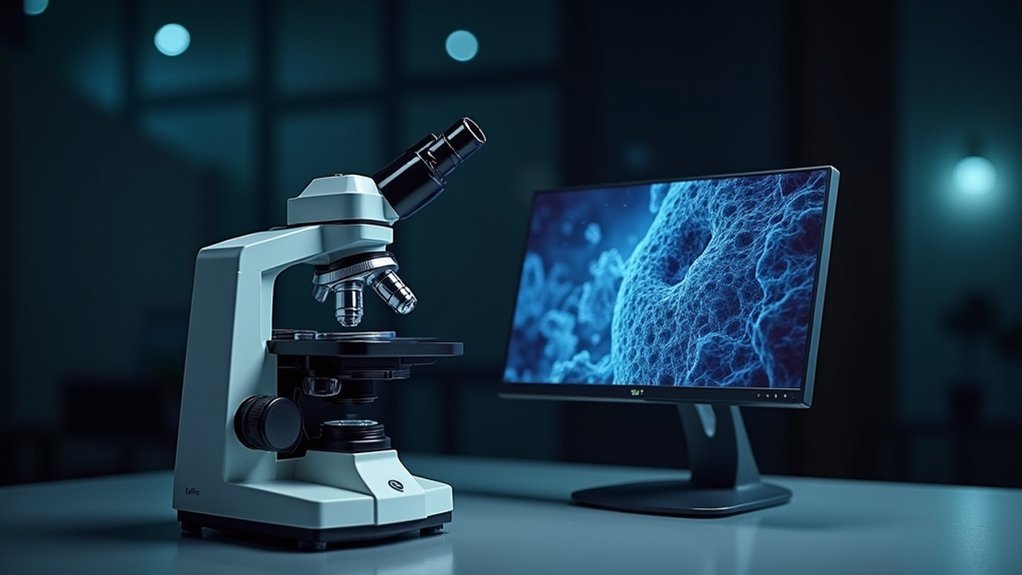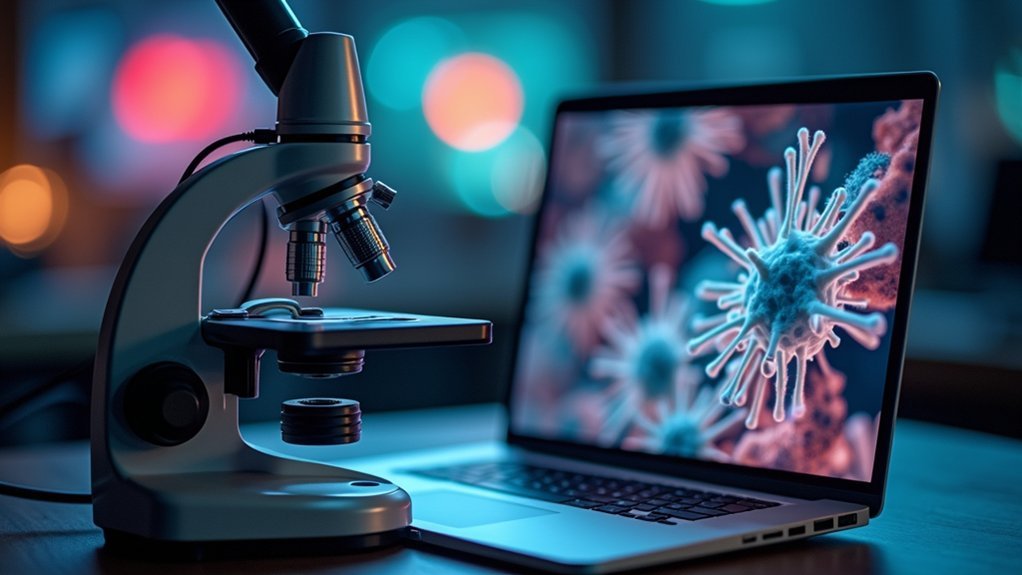For imaging experts, top microscope streaming solutions offer multi-dimensional acquisition, real-time processing, and resolutions up to 4096×4096 pixels. Look for software with super-resolution capabilities (like SRRF-Stream+), multi-user collaboration features, and quantitative analysis tools. You’ll need seamless integration with your microscope model and CUDA-compatible GPU support for parallel processing. Your ideal platform should balance sophisticated processing with intuitive controls while supporting your specific research applications. The following guide explores these essential features in depth.
Essential Features of Top-Tier Microscope Live Streaming Platforms

When selecting microscope live streaming software, you’ll need to prioritize platforms that offer seamless integration with various microscope models and cameras.
The best microscope imaging software delivers high-resolution image output capabilities—some achieving an impressive 4096 x 4096 pixels—ensuring you capture every detail during real-time imaging sessions.
Superior microscope software captures every microscopic detail in stunning 4K+ resolution during real-time observations.
Look for solutions with both auto and manual exposure adjustments to optimize different samples under various conditions.
Top programs support multi-dimensional acquisitions including multi-channel, Z-stack, and time-series imaging, enhancing the versatility of live observations.
Your workflow will benefit from a user-friendly interface that minimizes the learning curve.
Additionally, extensive tutorial resources are invaluable for maximizing your digital cameras’ potential while streamlining complex imaging tasks.
Real-Time Image Processing Capabilities for Scientific Research
Although microscope cameras capture detailed imagery, it’s the real-time processing capabilities that transform raw visual data into actionable scientific insights.
When you’re studying dynamic processes, software like SRRF-Stream+ delivers super-resolution imaging down to ~100nm, revolutionizing your live cell imaging research workflows.
LAS X software enhances your ability to analyze intracellular structures in real-time, while QuickPHOTO’s time-lapse capturing features let you monitor biological samples continuously with precise timing.
For thorough specimen analysis, JENOPTIK GRYPHAX® software’s Panorama tool creates seamless panoramic views, expanding your observational scope.
You’ll experience significant efficiency gains when utilizing CUDA-compatible GPU integration, which enables parallel data acquisition and processing.
These advanced imaging techniques guarantee you won’t miss vital cellular events, making your research both more productive and revealing.
Multi-User Collaboration Tools for Remote Microscopy

Four revolutionary collaboration capabilities have transformed microscopy from a solitary pursuit into a globally connected research activity.
Modern multi-user collaboration tools now facilitate real-time sharing of live imaging sessions, bringing researchers together regardless of location.
Live imaging sessions unite researchers across continents, breaking down geographical barriers through real-time microscopy collaboration.
- Simultaneous access allows multiple researchers to control microscope functions, enabling collaborative research without physical presence.
- Integrated video conferencing supports immediate discussion of findings during observation, eliminating communication delays.
- Advanced annotation tools permit users to mark and comment on images in real-time, enhancing data analysis efficiency.
- Remote desktop compatibility guarantees you can connect to microscopy systems from various devices, maintaining workflow continuity.
These features collectively transform remote microscopy from a limited viewing experience into a fully interactive collaborative environment.
Hardware Compatibility and System Integration Options
When selecting microscope streaming software, you’ll need to match your camera specifications with compatible programs using a camera-microscope compatibility matrix.
You can connect JENOPTIK cameras with their GRYPHAX® software or pair Andor cameras with SRRF-Stream+ for high-resolution imaging.
Cross-platform integration allows you to incorporate motorized microscope stands with focus drives and USB 3 CMOS cameras into your Windows 10 Pro or Windows 11 system for a complete streaming solution.
Camera-Microscope Compatibility Matrix
Selecting the right camera-microscope combination is critical for successful live streaming in microscopy. Your imaging software must align with both your camera model and operating system to guarantee seamless integration.
For instance, JENOPTIK GRYPHAX software works with multiple JENOPTIK cameras, while Leica offers Application Suite for Windows and Acquire for macOS users.
When evaluating camera-microscope compatibility, consider:
- Camera model specifications – SRRF-Stream+ functionality requires specific Andor cameras like iXon EMCCD or Zyla 4.2 PLUS.
- Operating system requirements – Some software runs exclusively on Windows or macOS.
- Hardware integration capabilities – Look for support for computer-controllable illuminators and magnification encoders.
- Adapter compatibility – Canon EOS DSLR or mirrorless cameras require dedicated adapters for high-resolution output and adaptability in microscopy.
Cross-Platform Integration Capabilities
Hardware compatibility extends beyond basic camera-microscope pairing to encompass entire system integration across different computing platforms.
When selecting live streaming software, you’ll need to take into account OS requirements—Leica Acquire serves macOS users while LAS X and Enersight demand Windows 10 Pro or Windows 11 for peak performance.
JENOPTIK GRYPHAX® software excels at cross-platform integration, supporting multiple camera models and enhancing compatibility with third-party advanced image analysis tools.
Similarly, SRRF-Stream+ integrates seamlessly with selected Andor cameras like iXon series and Zyla 4.2 PLUS for existing microscopy setups.
For automation in imaging processes, QuickPHOTO’s integration with motorized focus drives offers precision across various microscope models.
The software’s application-specific versions guarantee compatibility with diverse microscope systems, allowing you to build a cohesive workflow regardless of your hardware ecosystem.
Data Management and Analysis During Live Microscope Sessions

Because microscopy generates substantial data during real-time observations, effective management and analysis tools have become essential components of modern live streaming software.
When you’re conducting live imaging, you’ll need solutions that process information instantly while maintaining workflow efficiency.
Advanced software packages now offer integrated capabilities that transform real-time data acquisition into actionable insights:
- Quantitative analysis tools in platforms like QuickPHOTO enable direct measurements on live images, eliminating post-processing delays.
- Image management features in JENOPTIK GRYPHAX organize captures in Galleries for efficient data handling.
- Real-time observation with SRRF-Stream+ captures super-resolution images every 1-2 seconds without disrupting cellular physiology.
- Software compatibility with MicroManager facilitates multi-dimensional acquisitions, enhancing thorough time-series analysis.
Performance Optimization for High-Resolution Microscope Streaming
While capturing microscopic details at high resolution demands substantial computing resources, you’ll need strategic optimization to achieve smooth live streaming performance. Equip your system with high-performance cameras like iXon EMCCD or Sona that support real-time imaging at resolutions down to ~100nm.
Install a CUDA-compatible GPU such as the GTX 1080 to enable parallel data acquisition and SRRF processing. This hardware acceleration is vital for maintaining frame rates of 1-2 seconds during live streaming.
Integrate your setup with 64-bit MicroManager or Andor SDK to facilitate multi-dimensional acquisitions and handle 4096×4096 pixel outputs efficiently. Regular imaging software updates guarantee you’re leveraging the latest performance enhancements for high-resolution microscope streaming, ultimately improving your data analysis capabilities.
Frequently Asked Questions
How Does Microscope Streaming Software Handle Bandwidth Limitations?
You’ll find microscope streaming software handles bandwidth limitations by adjusting resolution, using compression algorithms, implementing buffering systems, and offering frame rate controls so you’re able to maintain stable connections during live observations.
Can Microscope Live Streaming Be Secured Against Unauthorized Access?
Yes, you can secure microscope live streaming using encryption, password protection, VPNs, and access controls. Implementing two-factor authentication and network segmentation further prevents unauthorized users from accessing your sensitive microscopy data.
What Certification Standards Should Microscope Streaming Software Meet?
Your microscope streaming software should meet HIPAA, GDPR, ISO 27001, FDA 21 CFR Part 11, and IEC 62304 standards. These guarantee data security, patient privacy, and quality management in medical and research applications.
How Do Different Software Packages Compare in Pricing Structures?
You’ll find pricing varies widely: subscription models (ZEN Connect) vs. one-time licenses (CellSens), freemium options (Micro-Manager), and tiered packages (LAS X) based on features. Compare monthly costs against perpetual licenses for long-term value.
Are There Mobile Applications Available for Monitoring Microscope Streams?
Yes, you’ll find several mobile apps like MicroManager Mobile, Microscope Connect, and LabCam that let you monitor microscope streams remotely from your smartphone or tablet while away from your workstation.
In Summary
You’ll find that the right microscope streaming software transforms your imaging workflow. When selecting your platform, prioritize real-time processing capabilities, seamless collaboration tools, and broad hardware compatibility. Don’t overlook data management features and performance optimization settings—they’re essential for maintaining image quality during extended sessions. By choosing software that addresses these key areas, you’ll maximize both efficiency and research outcomes.





Leave a Reply